
Different types of Chandelier Crystals
The History of Chandeliers
The chandelier has gained a reputation as one of the most popular decorative objects throughout history. Since its beginning, it was a symbol of accomplishment and social status. The name itself was a synonym for luxury, power, and high society.
The word ‘chandelier’ originates from the French word ‘chandelle’ which means candle. The earliest chandeliers were of simple design: two wooden beams forming a cross, with spikes at the end to retain candles made of animal fat. It was the expense of good quality candles made chandeliers exclusive luxury items from their conception. They were first used in Europe at the end of the 9th century by the Church and soon afterwards in castles and royal palaces.Chandeliers were originally candle holders and were hung from the ceiling to illuminate a room and reduce the risk of fire.
The Basics of Chandelier Crystals
All crystals are made of glass. However, the glass used to craft chandelier crystals is very different from the glass in your windows, drinking cups, eyeglasses and so on. Crystal contains lead oxide, which gives it more weight and more refraction than normal glass. This means crystal is more brilliant, sparkles more and is prismatic.
Lead oxide content is important in crystals for chandeliers, but it is also safe for the health of consumers. The rule is that the more lead oxide there is in the crystal, the better it reflects light, so a higher lead oxide content is better. There are three broad types of lead oxide content:
- Crystalline is glass with 6 to 10 percent lead oxide, though American standards allow clear glass with any amount of lead oxide to be called crystal.
- Half lead designation means 24 percent to 30 percent lead oxide.
- Full lead crystal is anything over 30 percent lead oxide.
There are three basic methods of crafting crystals for chandeliers: machine cut, hand cut and hand-blown.
Machine cut crystals produce sharp facets, precise polishing and visual purity.
Hand cut crystals are sometimes crafted with traditional methods that use irons and sandstone wheels for cutting, followed by polishing on a wood wheel with marble dust in it. But hand-cut crystals are also made with more modern methods. Some varieties of hand-cut crystals include Czech, Heritage, Regal, Crystalique and Turkish.
Venetian and Murano crystals are hand-blown by artisans instead of cut, so the crystals have smooth, rounded edges. The mouth-blown craftsmanship results in one-of-a-kind heirloom quality pieces that are works of art.
Crystal Glass Today
Modern chandeliers and ceiling fixtures use crystal glass in very much the same way. Crystal Chandeliers help create a visual focal point that draws the eye and brings upon the suggestion of a romantic, magical intimacy that other types of lighting simply are unable to reproduce.
Not all crystal is alike, however. There are many different types of crystal glass available today in a wide range of styles, cuts and prices.
Chandelier Crystal Cuts
Chandelier crystals, which can be cut and polished into various shapes and sizes, are called pendalogues, though sometimes it’s spelled pendeloques. Some common cuts of pendalogue include:
- Octagon: has eight sides and features various shapes of facet in tandem.
- Icicle: short, thin and pointed.
- Spear: longer than icicles, but also thin and pointed.
- Rosette: flower-shaped.
- Square stone: four-sided and often faceted to look like it bears a letter X.
- Swedish drop: a wide teardrop-shaped crystal with diamond-shaped facets. May also be called pear.
- Kite: kite-shaped, featuring many small similarly-shaped facets. Differs from diamond because the top two angles are usually longer than the bottom two.
- Hexagonal prism: long, thin drops with six-pointed tips cut at an angle.
- Baguette: also sometimes called colonial, these are thin, long, rectangular and generally flat on one side while raised and faceted on the other.
- Finial: small and circular with triangular facets, this often hangs alone at the very bottom of a chandelier.
- Cut ball: orb-shaped and featuring many triangular facets.
- French: flat on one side and raised and faceted on the other, this is a highly detailed pear shape.
Some chandeliers might only use one kind of pendalogue while others feature many cuts!
Here’s are only a few types of Crystal used for Chandeliers:
Swarovski Elements Crystal Glass:
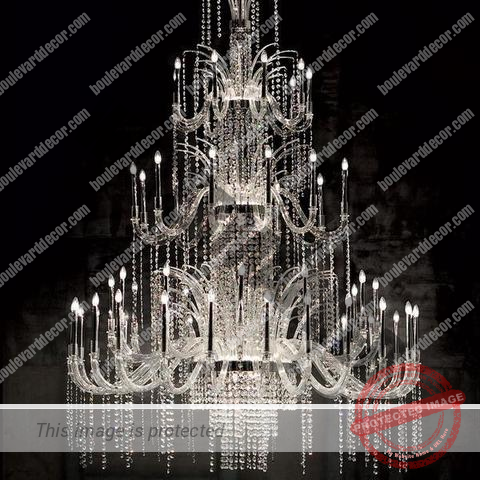
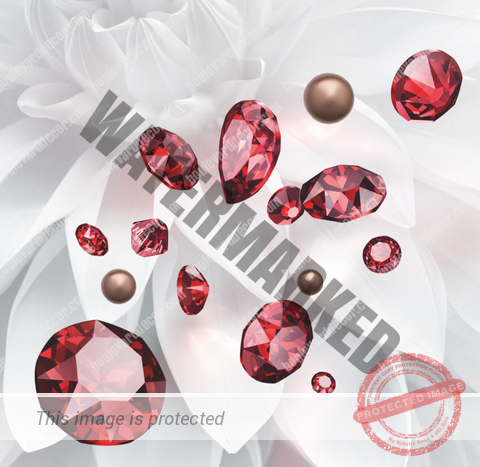
The finest crystal in the world, Swarovski Elements is manufactured by Swarovski AG in the Austrian Alps using a generations old secret process. Available in a wide range of colours, sizes and shapes, this collection of crystal glass offers a fabulous palette for lighting designers, as well as for designers in the worlds of fashion, jewellery and home accessories.
They are generally machine cut and then finally machine polished to achieve perfect optic clarity, razor sharp faceting and unique purity and brilliance. An invisible optical coating is then applied to Swarovski Elements glass, making it easier to clean and maintain. And to protect buyers against imitations, the company logo is laser etched in miniature inside each crystal element.
They’re known for having perfectly sharp faceting but are certainly on the expensive side. They’re made in the Austrian Alps and come with a lead content of over 30%. These are also excellent options for those looking for crystals in a variety of colors.
However, they’re also on the expensive side, which means you should be prepared to make a bit of an investment. The cost likely has something to do with the history of the house itself. Its founder, Daniel Swarovski, was the first person to ever use a machine to cut and polish glass.
Today, in addition to being used for chandeliers, Swarovski crystals are also used to create stunning pieces of jewelry.
Spectra Crystal:
Swarovski crystal glass is manufactured by Swarovski AG. Generally less expensive than other Swarovski crystal, Spectra crystal is offered only in limited sizes and shapes compared with Strass crystal.
Egyptian / Moroccan Crystal (Gem cut):
Gem cut crystal is first quality, machine cut crystal glass of a clarity and flawlessness far beyond industry standards. Though not as good as Strass or Swarovski crystal, gem cut is characterized by a prismatic brilliance, visual purity, sharp faceting and precise polishing all its own.
Strass Crystal
This crystal is highest quality throughout the world and manufactured in Austria. It is considered a premium brand due to patented anti-dust coating which is an invisible type of optical coating to make it easier for cleaning and maintaining.
Gem Cut Crystal
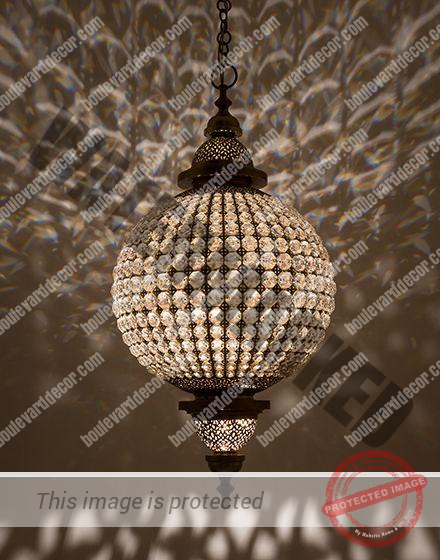
Egyptian, gem cut, spectra lead crystal that are made with 24 to 30% lead oxide will be the best refractive crystal. You will not find any noticeable difference between 24% or 30% machine-polished type lead crystals. Using lead can improve clarity and can soften glass for cutting.
This type of crystal has excellent shine and shimmer, but also requires a good amount of upkeep. However, the upside is that these crystals are especially flawless, and have a good amount of lead oxide in them. You’ll need to clean the gemcut crystals about once every 2 months to keep them bright and shiny.
Turkish Crystal
Turkish crystal uses mixture of oxides that is other than lead, e.g. soda ash, for achieving high optical clarity as well as refraction of light which closely rivals a full-lead crystal. As per EU any glass must contain minimum 10% oxides for carrying the label “Crystal”.
Murano Glass
This glass is made in Murano Island in Italy and it combines sand, quartz, soda, potassium along with lead oxide at high temperatures. Glass will be blown and stretched with hand and allows artisans to create very delicate floral and few other unique shapes.
Wood-polished Crystal
It involves few labor-intensive processes to create wood-polished crystal, which is first cut simply by using hand in 2 stages, first on iron, next on sandstone grinding wheels.
After that each crystal will be polished on certain wood wheel that having marble dust.
Italian Crystal (Legacy, Venetian):

This crystal comes from the historic glass-making region around Venice and has a look and feel all its own. Venetian crystal is moulded and fire-polished rather than hand or machine cut, resulting in a beautifully subtle luminosity. It is modestly priced, compared with cut crystal.
This type of lead-free crystal can be used for antique reproductions in order to accurately reproduce antique, as lead crystal was not invented before 17th century. This Italian crystal is from historic glass-making region that is around Venice and it has got look all its own. This crystal is fire-polished and molded rather than machine or hand cut, that results in beautifully subtle luminosity.
Venetian glass is famous across the globe for its beauty and clarity. For quite literally hundreds of years, Venice, Italy has been world-famous for its stunning Murano glass. In addition to using this glass to make tableware, vases, and jewelry, it’s also used to create gorgeous chandeliers.
So, what sets it apart from the rest? Instead of being polished in a machine or cut by hand, it’s molded and polished by fire. This is what gives Venetian crystal its trademark shimmer.
Lead free Crystal
This type of machine-polished and lead-free crystal can be the nearest quality level to a Strass crystal that we discussed above. High-quality machine polishing will leave no trace of polishing on facets of crystal. While this can be less expensive as compared to Strass crystal, there are few who may argue that handcrafted nature this crystal can elevate it above any machine-made crystal.
Chinese Crystal
They are made by soda, sand and lime all heated in furnace, after that pressed. Such glass is very inexpensive. These Chinese crystals will be cut and polished more like expensive grades, however lacks high optical quality and also precision facets.
Aurora Borealis Crystal
Usually any clear crystal requires direct light for creating lovely rainbows effect, while Aurora borealis crystal will look beautiful without direct light too. The treatment for Aurora borealis is applied to prism’s one side and looks almost like multi-colored rainbow, reflected through this prism.
Turkish Crystal (Hand cut, Heritage Hand cut, Regal):
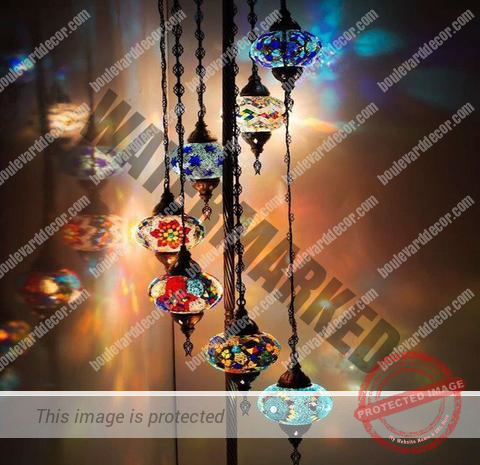
The methods of producing this type of crystal date back centuries. In a labour-intensive process, crystal is first cut by hand in two stages on iron and then sandstone grinding wheels. Then each crystal is polished on a wood wheel with marble dust. You may notice faint traces of the wood wheel in finished pieces, a mark of authenticity.
Hand-cut crystals, also called Turkish or Regal crystal, is one of the oldest types of crystal. As the name implies, it’s cut by hand on iron and sandstone wheels, and polished using marble dust.
Though lovely, handcut crystal isn’t just expensive – in some cases, the marks from the wheels may be visible. There are also hand-blown options, perfect for those who prefer their crystals to have smoother edges.
K9 and Chinese Crystal:
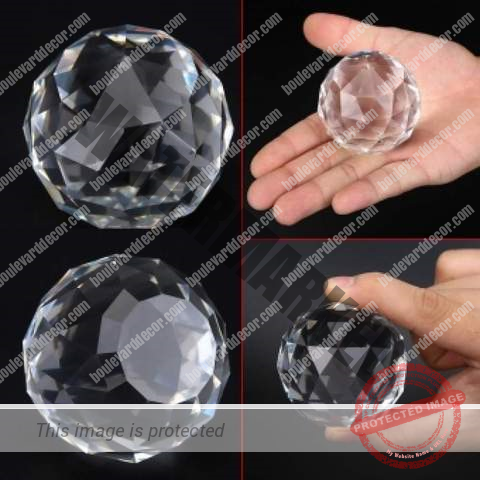
One of the most popular types of crystal used in the construction of chandeliers is K9 crystal. It’s a Chinese Optical Borosilicate Crown Crystal with low inclusions and imperfections, and doesn’t usually require many incisions when cutting it down to the perfect shape. It’s also appreciated for its low dispersal properties.
It’s made from glass borosilicate crown, and uses optical crystal as opposed to lead oxide. Interestingly, optical crystal is the same material used in the Hubble Telescope’s lenses. This is because optical crystal is much clearer than either leaded crystal or glass, as it’s almost entirely free of bubbles and scratches.
Its clarity comes from the way in which it’s produced. It’s heated to record-breaking high temperatures and then brought down to cooler temperatures slowly to avoid inconsistencies.
K9 crystal is about 15% lighter than leaded crystal, which means that you won’t have to worry about the chandelier damaging your ceilings or worse, falling and breaking. It’s also durable, so you won’t have to worry about accidentally cracking the crystals when you clean or move your chandelier.
Because K9 crystal has a high refractive index, it offers more “shimmer” than other kinds of crystal. It also possesses incredible clarity, which helps to create consistently, brighter reflective lighting patterns. It’s ideal for a truly statement-making chandelier that commands attention in any room.
Best of all, however, is K9 crystal’s affordability. Because of the intricacy of the designs and the high reflective content, many buyers expect to be priced out of chandeliers made from K9 crystal. However, it offers a luxury look at a surprisingly affordable price point. It offers a much more competitive price point than many other kinds of crystal, thanks especially in part to its lower production costs. It’s also one of the most common crystal types used in luxury chandeliers – so don’t assume it’s low cost means having to compromise on quality.
Mass produced, this crystal type offers a wonderful look at a modest price. It is cut and polished like more expensive grades, and has a high optic quality with precision facets. A good bet for consumers looking for high value and more for less.
K9 crystal offers a high refractive index and high clarity making it a good option for the manufacture of high-end chandeliers offering both durability and excellent quality.
The US equivalent to K9 is BK7. The K5 is even cheaper quality used for low budget chandeliers. K9 and K5 just describes the raw material not the cut and polishing that may vary.
Asfour Crystal:
Asfour Crystal is the world’s largest producer of full lead crystal. They are an Egyptian crystal manufacturing company that produces crystal pieces under its own name. The company produces clear and coloured crystals for diverse uses including lighting, accessories, fashion pieces, chandeliers, figurines and special projects.
Original Asfour crystals are engraved with the ASFOUR emblem. Having that emblem on your crystal means that it will remain as luminous as the day you acquired it and for decades to come.
Asfour crystal always gives a dazzling rainbow reflection when exposed to the light, and you can easily tell one apart from any other crystal with the efficiency and precision of the crystal’s cuts.
AUTHOR: Darius Du Plessis



